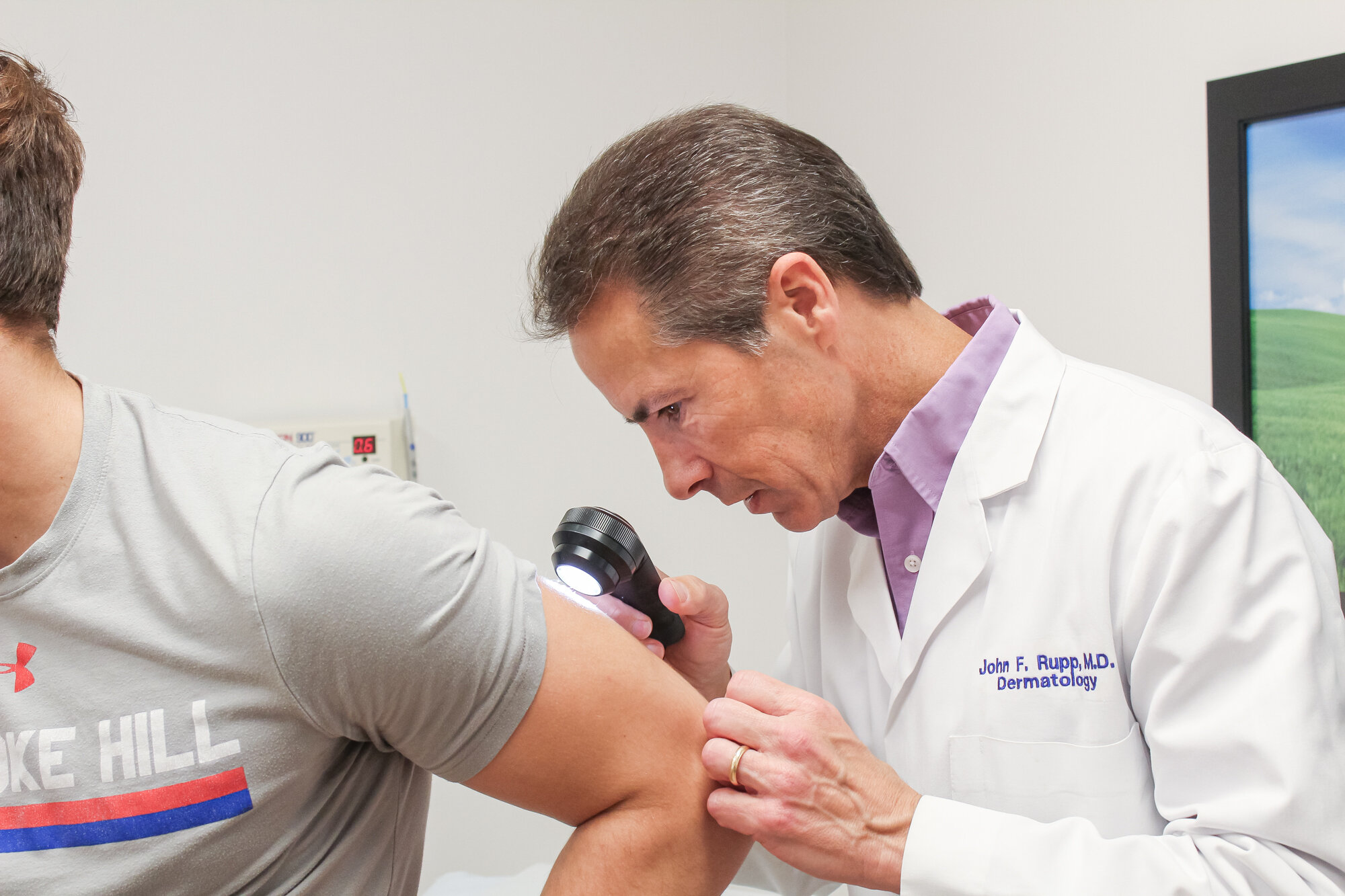
Moles
Kansas City’s Mole Exam and
Removal Professionals
Have you ever noticed the brown spot on Mariah Carey’s or Scarlett Johanssen’s face? These are often referred to as “beauty marks.” Even though moles do give a person a certain uniqueness, they can sometimes signal an early stage of cancer.
We at Dermatology Specialists of Kansas City have been performing skin exams for over 20 years. We can perform a thorough, full body skin exam, or examine a limited area to your liking. Our skin care professionals can assess the moles and lesions on your skin and remove them if necessary.
Usually, moles are tan, brown to dark brown spots on the skin. Moles can also be other colors such as pink, red, blue, or colorless. They can vary in size and shape. The brown color in moles is caused by special pigment cells called melanin. Dark, flat moles, changing moles, or moles that look different than your other moles raise suspicion of progression of that mole to a serious skin cancer known as melanoma. Did you know that the famous singer, Bob Marley, died from melanoma that started on his big toe?
Have your moles checked.
Call us at (816) 942-1150 or
What are moles?
Moles are also called nevi (one mole is a nevus) and can be any spot on the skin that is made up of cells that originate from the skin. Brown moles are collections of pigment cells, which are a natural part of the skin.
You may have been born with one or a few moles. Some moles simply appear throughout life, and sometimes moles appear because of sun exposure. Lighter-skinned people tend to have more moles than darker-skinned people.
Certain families have a predisposition to develop many moles, and some of them may turn into skin cancer. Knowing your family health history is important, as well as seeing a dermatologist often to examine and observe the moles.
Know your ABCDE’s of Melanoma
Recognize the warning signs of dangerous moles that can turn into skin cancer (malignant melanoma) by using this easy-to-remember guide:
A - stands for asymmetry. Beware of moles where one half doesn't match the other half in shape.
B - stands for border. Watch for moles with ragged, blurred or irregular borders or edges.
C - stands for color variation. Look for uneven coloration, more than one color, or moles with unusual colors.
D - stands for diameter. Give special attention to moles with a diameter larger than the size of a pencil eraser.
E - stands for evolving. If you think that a mole is changing in its appearance, have us examine it.
Keeping an eye on moles is an important part of your total skin health. If you have a mole that fits these descriptions or see any moles that have changed in appearance, color or size, please contact Dermatology Specialists of Kansas City for an appointment.
How are moles removed?
Not all moles need to be removed. The skin care professionals at Dermatology Specialists can assess which mole or moles should be removed and checked for cancer cells.
Most moles are harmless. But you may also want a mole removed because it is in an area that bothers you, such as on your face, under a bra line, or under your arm.
Dr. Rupp and his well-trained and experienced Physician Assistants can use various methods to remove moles. All mole removals are done under local anesthesia, where only that area is numbed so you won’t feel any pain. A shave removal is when your provider shaves the mole flat with the skin. A scoup shave removal is when the provider shaves the lesion slightly deeper in order to get the entire mole. These usually heal in flat with the skin surface without requiring stitches. A punch removal is when a small “cookie cutter” the size of a pencil eraser is used to cut around the mole. A stitch or two is required to close the tiny opening, thus minimizing any scar. With a larger mole, “excising” or cutting it out with a scalpel may be needed. This usually requires a handful of little stitches to have it heal well with minimal scarring. We at Dermatology Specialists are always mindful of those moles that need to be removed while keeping in mind the cosmetic outcome.
The Mole Removal Procedure
Once we have determined which mole is to be removed, we sit and discuss the pros and cons of removal. When your questions are answered and you are ready, you are usually reclined on the table. The area of skin is well cleaned and numbing medication is placed in the area. We use a very tiny needle to administer the anesthesia, as well as use certain techniques to minimize any feeling that you may get from the numbing. Once the area is completely numb, your provider will use one of the above-mentioned methods to remove your mole. If stitches are placed, they will need to be removed by us in 7 – 14 days. The procedure can take between 10 to 20 minutes. When the procedure is over, the area will be disinfected again (to help prevent infection) and ointment will be applied under a bandage. We will go over how you are to care for the area when you are home. That’s it! Simple.
Dr. Rupp recommends
SkinMedica Scar Recovery Gel
If you want to do everything you can to help the scar from your mole removal heal well, Dr. Rupp and the Physician Assistants recommend Centelline Scar Healing gel. Starting about two weeks after the procedure, a small amount of Centelline gel can be gently rubbed in over the scar line twice daily for the next 2 months. Click here to view SkinMedica products and shop online. Centelline is also available in the office for purchase when you visit.
Good Advice!
It is a good idea to get to know the moles that you can see. If you get an idea of what they look like, and you periodically look at them, it is easier to determine if they might be changing. We at Dermatology Specialists of Kansas City recommend performing a self skin exam every one to two months in order to catch anything changing or something odd. Sun protection is also important, as moles can change with exposure to the sun. If you have any questions about a mole, do not think that you are wasting our time with your visit. Our mission is to keep you and your skin as healthy and happy as possible.




